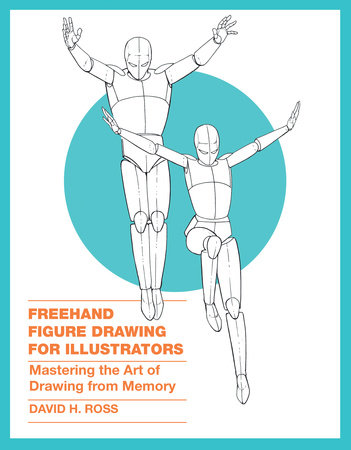Excerpt
Freehand Figure Drawing for Illustrators
IntroductionThe term
freehand drawing describes the practice of drawing from the imagination without the aid of a live model or photographic reference.
Freeing the artist from any dependency on such sources allows for maximum versatility—the artist is restricted only by his or her imagination or skill level. As it applies specifically to the human figure, it is the drawing of the body in any pose imaginable and from any angle—without the need for a reference.
Freehand Figure Drawing for Illustrators offers up a constructive approach to drawing the human form that can be traced back to the early 1900s. Illustrators of that era developed a system for blocking out the human figure using a
drawn mannequin.
This book focuses on that drawn mannequin, putting it through its paces in ways that those early illustrators could not have foreseen. There are studies of standing, walking, and running figures, of course, but also leaping, dodging, and flying ones. Mannequins throwing punches and high kicking demonstrate the mechanics of motion and will help you to examine the limitations of the body’s movement. The drawn mannequin is nothing more or less than a visualization tool—a simplified representation of the human body that enables the artist to block figures into place with proper proportions and posing.
It is particularly useful when dealing with more complex camera angles (for example, the bird’s-eye and worm’s-eye views). With a drawn mannequin, the artist doesn’t have to deal with the details of specific anatomy, folds in clothing, or lighting and can focus on achieving a solid, well-constructed underdrawing (or mannequin), first.
The mannequin is transparent (which is why it’s also known as a
glass mannequin) to help the artists using it think of what they are drawing as three-dimensional or
in the round. This is a crucial mind-set for artists to attain. They must think of everything they draw as having
volume—of occupying space—if they wish that sense to be conveyed to their audience. On an even more practical note: the mannequin’s transparency allows the artist to locate the sometimes obscured connection of that far arm or leg to the trunk of the body.
Mannequins used in this book range from basic to intermediate to advanced. Each successive category introduces more human anatomy into the mannequin figures, enabling you to progress in stages. I have varied the mannequins throughout the book on a need-to-see basis. Earlier chapters contain a higher percentage of basic mannequins, while later ones such as those in chapter 10 are weighted toward the advanced model.
The first chapter of this book offers a primer in technical perspective. This is a necessary first step for those considering freehand drawing of any sort. The ability to visualize in three dimensions on the flat page or screen is indispensable to the process. The fundamentals outlined in chapter 1 will help instill in you a heightened sense of depth, which you can then apply directly to drawing the human figure.
Your ability to draw convincing poses—both in form and in gesture—will increase in direct proportion to your understanding of anatomy. The study of human anatomy is included in this book, both as sub sections in the chapters covering the head, hands,
and feet, as well as in whole chapters devoted to the human skeleton (chapter 8) and
the muscles (chapter 9). The skeleton is the foundation that shapes the body; however,
it is the muscles that make the body “move.” Ingrained anatomical knowledge is espe-cially important for the freehand artist, since there is no actual model or other reference immediately at hand to guide you. If you can include muscle tone and bone-related landmarks in your freehand sketching, it will greatly add to your speed and versatility.
Freehand Figure Drawing for Illustrators is for anyone who has ever dreamed of picking up a pencil and drawing spontaneously from the imagination. That being said, it certainly does represent a valuable skillset for the professional artist whether working in the field of animation, cinematic storyboarding, concept art, or book and comic book illustration.
Beyond all other considerations, however, there is the simple satisfaction that can come from adopting the freehand approach. This is what drawing should be about, straight from the mind to the page with no stops or detours along the way!




